-
ORIGINAL ARTICLE12-16-2024
Editorial discourses in the history of Acta Paulista de Enfermagem (1988-2017)
Revista Brasileira de Enfermagem. 2024;77(6):e20230362
Abstract
ORIGINAL ARTICLEEditorial discourses in the history of Acta Paulista de Enfermagem (1988-2017)
Revista Brasileira de Enfermagem. 2024;77(6):e20230362
DOI 10.1590/0034-7167-2023-0362
Views0See moreABSTRACT
Objectives:
to analyze the editorial discourses of Acta Paulista de Enfermagem from 1988 to 2017.
Methods:
qualitative, historical, oral research, with interviews with the journal’s editors. Statements were categorized and presented in three decades, discussed from Foucault’s archaeological perspective.
Results:
seven statements presented three discourses. In the first decade, the discourse of knowledge registration and circulation presented statements of graduate studies and professional recognition. In the second decade, knowledge internationalization was added, with statements of business and editorial panopticism, selection criteria, indexing and digitalization. Finally, the discourse of shifting scientific assessment centrality was added with statements of preprint, open science, exclusive digitalization and mediatization of science.
Final Considerations:
the journal needed to adapt to form its official discourse, which made it possible, over the years, to change its initial peripheral position to a central one within scientific communication, supporting its panoptic role.
-
REVIEW12-16-2024
Strategies for expanding vaccination coverage in children in Brazil: systematic literature review
Revista Brasileira de Enfermagem. 2024;77(6):e20230343
Abstract
REVIEWStrategies for expanding vaccination coverage in children in Brazil: systematic literature review
Revista Brasileira de Enfermagem. 2024;77(6):e20230343
DOI 10.1590/0034-7167-2023-0343
Views1See moreABSTRACT
Objectives:
to identify the strategies found in the literature for increasing vaccination coverage among children in Brazil. It is justified mainly by the current scenario of falling vaccination coverage.
Methods:
systematic literature review. The search was carried out in the Pubmed (MEDLINE), Embase and Scopus databases, following the PRISMA guidelines.
Results:
initially, 4,824 results were returned. In the end, 6 studies were included for narrative synthesis using the SWiM methodology. Of these, 50% dealt with studies related to the Bolsa Família Program (PBF). The others explored strategies for approaching parents directly, Rapid Vaccination Monitoring (MRV) and the Community Health Agents Program (PACS). The PBF did not guarantee compliance with the conditionality of keeping vaccinations up to date. The MRV and PACS are effective strategies, especially because they allow active search for absentees.
Conclusions:
we conclude that more publications are needed on strategies to increase vaccination coverage among children in Brazil.

-
ORIGINAL ARTICLE12-16-2024
Educational technology to empower patients as participants in their care
Revista Brasileira de Enfermagem. 2024;77(6):e20230359
Abstract
ORIGINAL ARTICLEEducational technology to empower patients as participants in their care
Revista Brasileira de Enfermagem. 2024;77(6):e20230359
DOI 10.1590/0034-7167-2023-0359
Views0See moreABSTRACT
Objectives:
to build and validate an educational technology to empower patients as participants in their own care.
Methods:
methodological study to develop an educational technology based on the elaboration, validation, and evaluation that were carried out in five stages at a teaching hospital in Amazonas. The study was carried out from 2019 to 2022, with the participation of 19 judges specialized in patient safety and 72 patients admitted to the hospital’s medical and surgical clinics, the study setting.
Results:
the agreement between the judges obtained an overall index of 0.85, being considered validated. The overall analysis of the booklet obtained an assessment of the level of agreement above 85%.
Final Considerations:
the educational technology presented here was validated and suitable for promoting patient/professional rapprochement and consolidating health care in a way that increases the patient’s ability to contribute to their treatment and prevent the occurrence of adverse events.
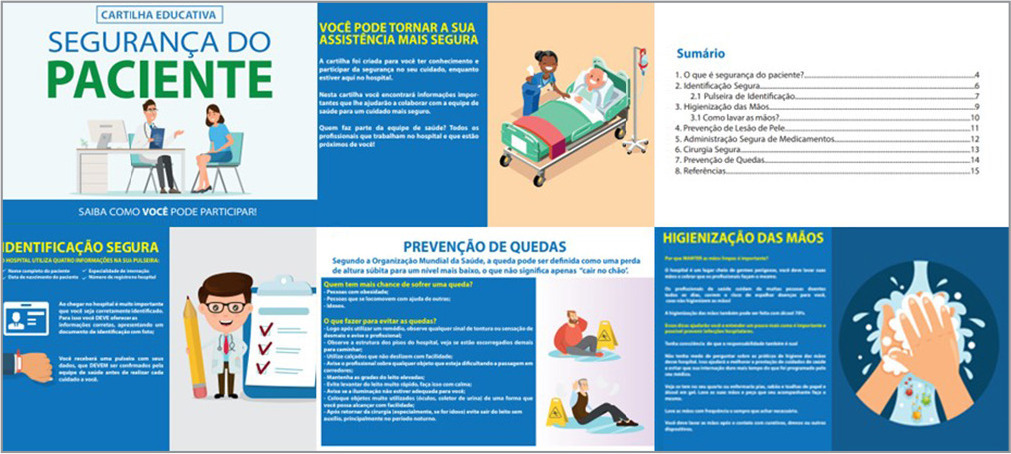
-
ORIGINAL ARTICLE12-13-2024
Educational booklet on labor and delivery: validity study
Revista Brasileira de Enfermagem. 2024;77(5):e20240138
Abstract
ORIGINAL ARTICLEEducational booklet on labor and delivery: validity study
Revista Brasileira de Enfermagem. 2024;77(5):e20240138
DOI 10.1590/0034-7167-2024-0138
Views2See moreABSTRACT
Objectives:
to develop and validate an educational booklet on labor and delivery for pregnant women.
Methods:
this methodological study involved constructing and validating a booklet based on Echer’s framework. We used the Content Validity Index and Cronbach’s alpha for content and face validation, selecting judges according to Fering’s criteria. We then conducted a clinical validation with the target population.
Results:
the booklet, developed based on evidence from an integrative review and validated by judges and the target audience, achieved global Content Validity Index of 0.919 and 0.913, respectively. After clinical validation with 22 pregnant women, it included 28 topics and 48 pages, with illustrations by a graphic designer.
Conclusions:
expert judges and the target audience considered this educational technology valid, deeming it a relevant tool for promoting the health of pregnant women.
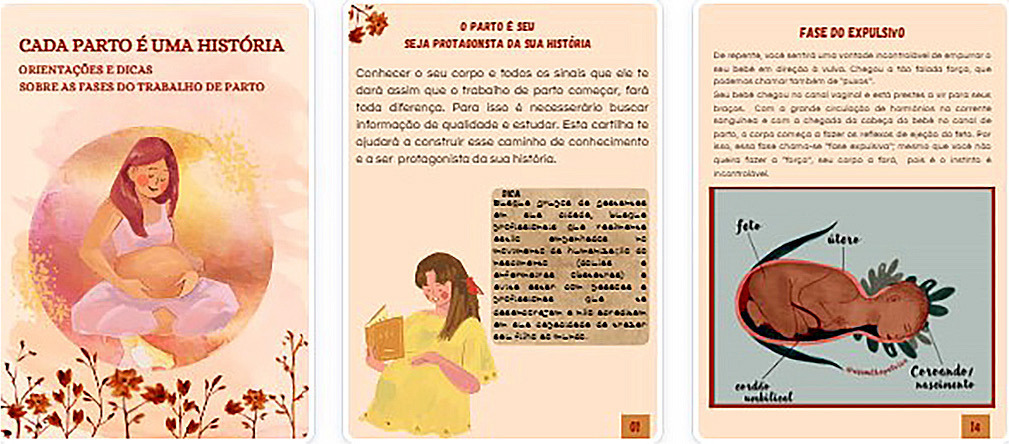
-
ORIGINAL ARTICLE12-13-2024
Interobserver agreement in Reception and Risk Stratification in Obstetrics implementation
Revista Brasileira de Enfermagem. 2024;77(5):e20230361
Abstract
ORIGINAL ARTICLEInterobserver agreement in Reception and Risk Stratification in Obstetrics implementation
Revista Brasileira de Enfermagem. 2024;77(5):e20230361
DOI 10.1590/0034-7167-2023-0361
Views0See moreABSTRACT
Objectives:
to analyze interobserver agreement in the Reception and Risk Stratification in Obstetrics protocol implementation.
Methods:
a cross-sectional study carried out during Reception and Risk Stratification in Obstetrics implementation, conducted in a tertiary hospital in southern Brazil with 891 participants in January 2020. Descriptive and interobserver agreement analysis was carried out using the Kappa coefficient in the risk stratification assigned by the triage nurse and reviewed by the researcher.
Results:
around half of the calls (55.6%) were stratified as not very urgent (green), followed by urgent (yellow) (31.8%), very urgent (orange) (9.3%), not urgent (blue) (3.4%) and no emerging stratification (red). Agreement analysis of revised stratification found Kappa values of 0.20 (blue), 0.54 (green), 0.77 (yellow) and 0.80 (orange).
Conclusions:
most appointments were non-urgent. The agreement analysis between the revised and assigned risk stratification revealed greater interobserver agreement as the priority level increased.
-
12-13-2024
Training of Brazilian indigenous nurses: between human rights, valuing diversity and inclusion
Revista Brasileira de Enfermagem. 2024;77(5):e20230430
Abstract
Training of Brazilian indigenous nurses: between human rights, valuing diversity and inclusion
Revista Brasileira de Enfermagem. 2024;77(5):e20230430
DOI 10.1590/0034-7167-2023-0430
Views0See moreABSTRACT
Objectives:
to analyze the possibilities and potential of training indigenous nurses, given the Brazilian Health System (SUS), understanding the relationships between education and health.
Methods:
theoretical-reflective study, based on scientific literature, aligned with the experience, critical thinking of its authors and the Sustainable Development Goals in Brazil.
Results:
this text articulates three axes: Potential for including indigenous students in nursing training; Paths to achieving equity through inclusion and retention policies for indigenous students at different levels; and Implications of this for the SUS and global health.
Final Considerations:
indigenous students, beneficiaries of affirmative actions, face challenges of inclusion and retention in public universities that directly impact their academic training. Added to this are the difficulties identified in basic education, professor training and implementation of permanence policies, with consequences for services and training at other levels.
-
ORIGINAL ARTICLE12-13-2024
Stress in nursing workers caring for people with COVID-19
Revista Brasileira de Enfermagem. 2024;77(5):e20230542
Abstract
ORIGINAL ARTICLEStress in nursing workers caring for people with COVID-19
Revista Brasileira de Enfermagem. 2024;77(5):e20230542
DOI 10.1590/0034-7167-2023-0542
Views1See moreABSTRACT
Objectives:
to analyze stress from the perspective of nursing workers caring for people with COVID-19 in a public hospital in the Recôncavo region of Bahia.
Methods:
this is an exploratory qualitative study, conducted through semi-structured interviews. The data were analyzed using word clouds, similarity trees, and content analysis.
Results:
nursing workers were exposed to stress while attending to patients with COVID-19. The reported stressors in the workplace included: work overload, lack of planning, speed in performing tasks, fatigue, lack of participation in decision-making, lack of support from management, technological changes, excessive responsibility without preparation, interpersonal conflicts, and professional undervaluation.
Conclusions:
exposure to these stressors leads to emotional exhaustion and demotivation, which were intensified during the COVID-19 pandemic.
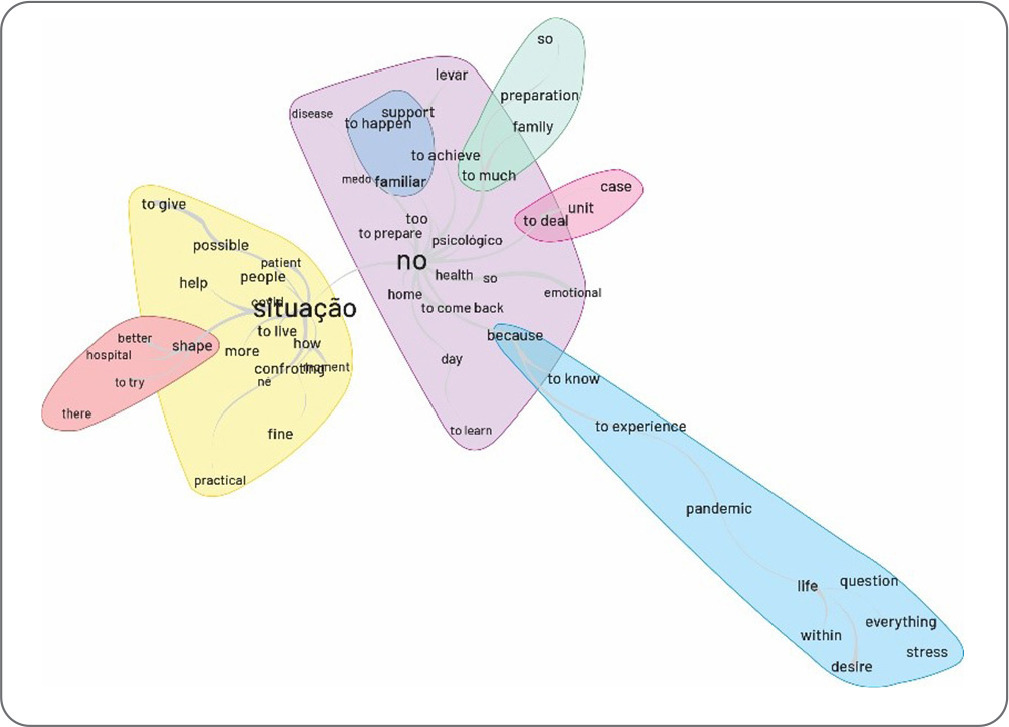
-
ORIGINAL ARTICLE12-13-2024
Adaptation and implementation of a Nursing care protocol for children in the Amazon Region
Revista Brasileira de Enfermagem. 2024;77(5):e20230245
Abstract
ORIGINAL ARTICLEAdaptation and implementation of a Nursing care protocol for children in the Amazon Region
Revista Brasileira de Enfermagem. 2024;77(5):e20230245
DOI 10.1590/0034-7167-2023-0245
Views0See moreABSTRACT
Objectives:
to describe the process of implementing an adapted protocol for pediatric nursing care in a health unit located in a municipality in the Amazon Region.
Methods:
methodological research conducted in a basic health unit with four family health teams in the state of Rondônia, involving seven nursing professionals. Data collection occurred between October 2020 and April 2022, following the research phases: situational diagnosis, exploratory phase, protocol definition, implementation, and evaluation.
Results:
the outcome was the adaptation and implementation of a nursing care protocol for children.
Final Considerations:
the adaptation and implementation process can be an effective approach to improving care, strengthening nursing as a profession with a solid foundation in scientific and clinical evidence. This facilitates early problem identification and appropriate guidance, leading to better health outcomes for children.
-
ORIGINAL ARTICLE05-28-2021
Cultural adaptation and validation of an instrument about nursing critical thinking skills
Revista Brasileira de Enfermagem. 2021;74(2):e20200720
Abstract
ORIGINAL ARTICLECultural adaptation and validation of an instrument about nursing critical thinking skills
Revista Brasileira de Enfermagem. 2021;74(2):e20200720
DOI 10.1590/0034-7167-2020-0720
Views1See moreABSTRACT
Objectives:
to validate the Nursing Critical Thinking in Clinical Practice Questionnaire regarding cultural aspects and metric properties.
Methods:
a methodological research carried out through cross-cultural adaptation, face and content validity, dimensional construct and known groups validity, test-retest reliability and internal consistency. 511 nurses from four hospitals participated in the study, of which 54 participated in retest.
Results:
the instrument validation for Brazilian Portuguese maintained equivalences, according to the original version. The dimensional validity demonstrated adjustment to the tetrafactorial structure of the original version (GFI=0.69). There were statistically significant differences in critical thinking skills between nurses with graduate degrees and who undertook training, reading articles, developing research and working in an institution with a longer time implementation of the Nursing Process. The instrument showed temporal stability (ICC 073-0.84; p<0.001) and adequate internal consistency (α=0.97).
Conclusions:
the instrument proved to be valid and reliable for the studied population.
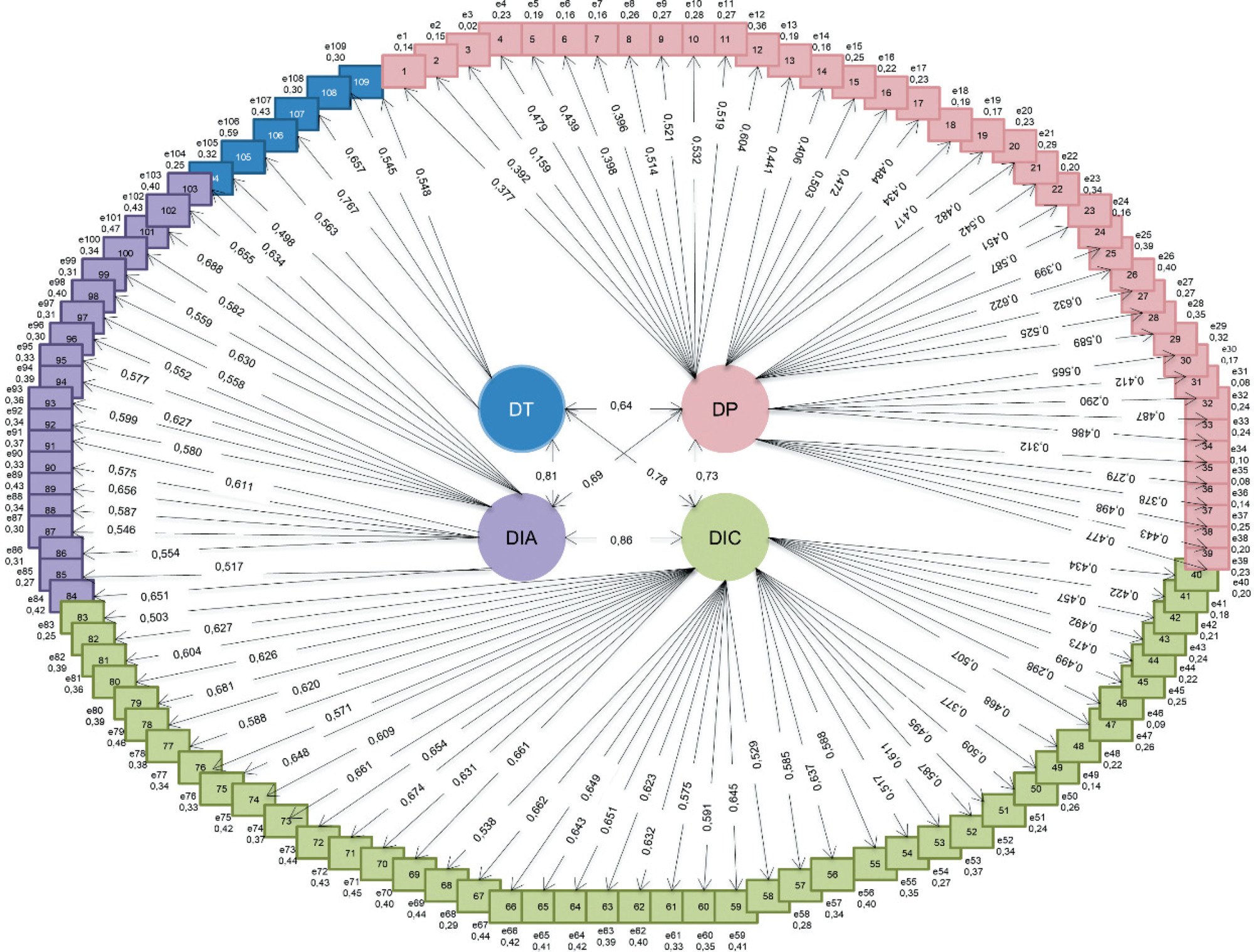
-
ORIGINAL ARTICLE07-30-2021
Curricular reforms in the transformation of nursing teaching in a federal university
Revista Brasileira de Enfermagem. 2021;74(4):e20201242
Abstract
ORIGINAL ARTICLECurricular reforms in the transformation of nursing teaching in a federal university
Revista Brasileira de Enfermagem. 2021;74(4):e20201242
DOI 10.1590/0034-7167-2020-1242
Views1See moreABSTRACT
Objectives:
to discuss the curricular reforms adopted for nursing teaching in Brazil, from 1969 to 2019.
Methods:
historical, qualitative approach using the thematic oral history and document research. 13 interviews were carried out with graduation nursing professors from a federal university in the South of Brazil. The document sources were the political-pedagogical projects of the course and their associated documents. Minayo’s thematic analysis was used.
Results:
nursing curricula delineates the profile of the professional that must be formed and are reviewed in order to be adapted to social and educational changes, showing the scientific and professional potential of the nurse. Curricular reforms consider the quality of nursing formation.
Final Considerations:
the structure of the curriculum and the reforms that took place emerged according to the historical, political, epidemiological and social context demanded from the profession, to attend to the demands of society and to the work market.
-
ORIGINAL ARTICLE06-11-2021
Social, health, and working conditions among hospital workers
Revista Brasileira de Enfermagem. 2021;74(2):e20200321
Abstract
ORIGINAL ARTICLESocial, health, and working conditions among hospital workers
Revista Brasileira de Enfermagem. 2021;74(2):e20200321
DOI 10.1590/0034-7167-2020-0321
Views0See moreABSTRACT
Objectives:
to compare social, health and working conditions among nursing, nutrition and hospital cleaning service workers.
Methods:
a quantitative cross-sectional, descriptive and correlational study carried out in a public hospital in the countryside of São Paulo, including workers from nutrition, cleaning and nursing services. Data collection occurred during working hours. Validated questionnaires and Karasek’s Demand-Control model were used to assess psychosocial dimensions and the Self-Reporting Questionnaire-20 to measure the common mental disorder. As dependent variable, the groups professionals and chi-square test were used for associations with p≥ 0.05.
Results:
227 workers participated. Positive associations were found between professional groups and socioeconomic, health and work characteristics.
Conclusions:
social, health, and working conditions differ between the professional groups studied.
-
ORIGINAL ARTICLE04-15-2022
Analysis of the temporal trend of mortality from sickle cell anemia in Brazil
Revista Brasileira de Enfermagem. 2022;75(4):e20210640
Abstract
ORIGINAL ARTICLEAnalysis of the temporal trend of mortality from sickle cell anemia in Brazil
Revista Brasileira de Enfermagem. 2022;75(4):e20210640
DOI 10.1590/0034-7167-2021-0640
Views0See moreABSTRACT
Objectives:
To analyze the temporal trend of mortality from sickle cell anemia in Brazil, by region, in the period 1997-2017.
Methods:
epidemiological study, with an ecological design, with a temporal trend, carried out with data from the Mortality Information System. For descriptive analysis, absolute and relative frequencies were used. In the correlation analysis, the ANOVA test was used, followed by Tukey’s post-test. The temporal trend was obtained using the cubic polynomial regression test.
Results:
6,813 deaths from sickle cell anemia were registered. Brown individuals (50.87%) were more frequent, with a predominance of males (50.4%), aged between 25 and 34 years and a higher incidence of deaths in the Midwest (0.25/100 thousand inhabitants). The time curve showed an increasing trend of deaths in the country between 1997 and 2015 (R2 = 0.98).
Conclusions:
sickle cell anemia showed increasing mortality in the 21 years analyzed and alerts health professionals and managers.
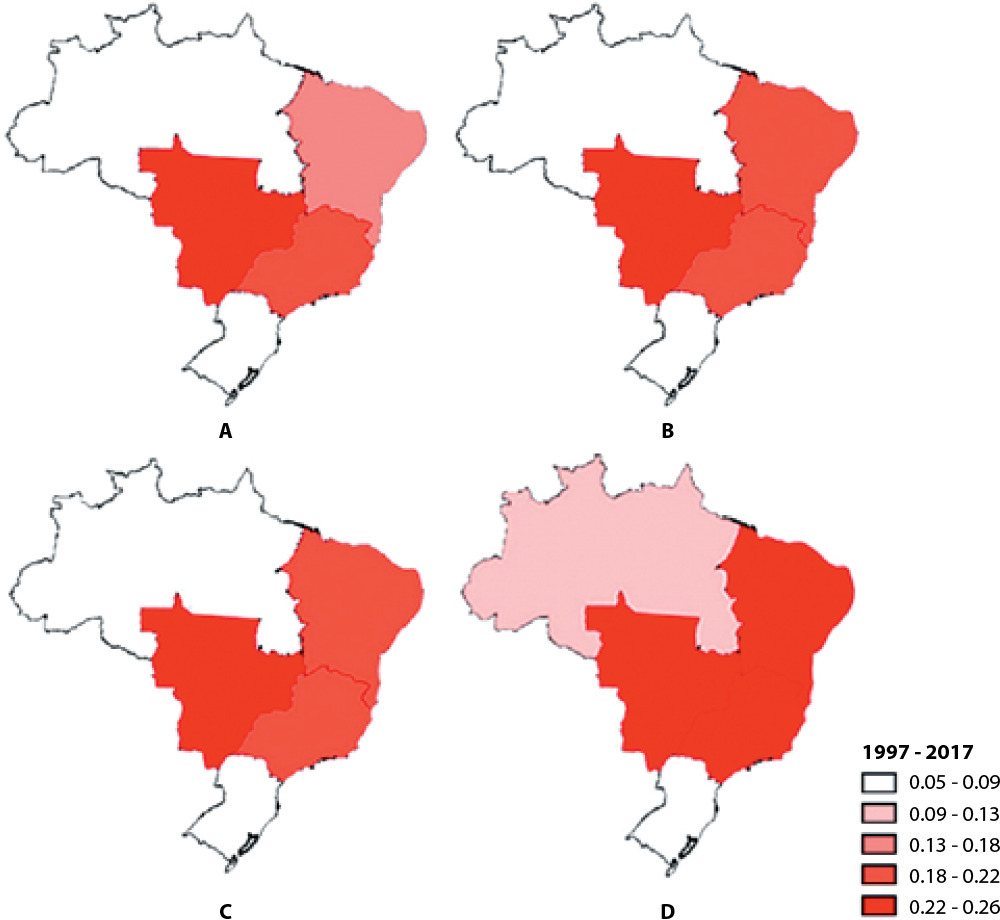
-
ORIGINAL ARTICLE09-29-2022
Construction and validation of an instrument for classifying nipple and areola complex lesions resulting from breastfeeding
Revista Brasileira de Enfermagem. 2022;75(1):e20210051
Abstract
ORIGINAL ARTICLEConstruction and validation of an instrument for classifying nipple and areola complex lesions resulting from breastfeeding
Revista Brasileira de Enfermagem. 2022;75(1):e20210051
DOI 10.1590/0034-7167-2021-0051
Views0See moreABSTRACT
Objectives:
to construct and validate a classification of nipple and areola complex lesions resulting from breastfeeding, according to content and appearance.
Methods:
this is a methodological study, developed in four stages: operational definition, instrument construction, content and appearance validation. The Delphi technique and a Likert-type scale were used to validate content and appearance, through the participation of ten and sixteen judges, respectively. For analysis, Content Validity Index and Kappa Coefficient were applied.
Results:
Content Validity Index obtained an overall value of 0.93 and, for appearance, 0.94. Kappa values ranged between 0.46 and 1. The high rates of agreement among judges demonstrated the quality of the proposed content validity.
Conclusions:
the Nipple and Areola Complex Lesions Classification Instrument developed obtained acceptable values of its indexes, proving to be valid in terms of content and appearance.
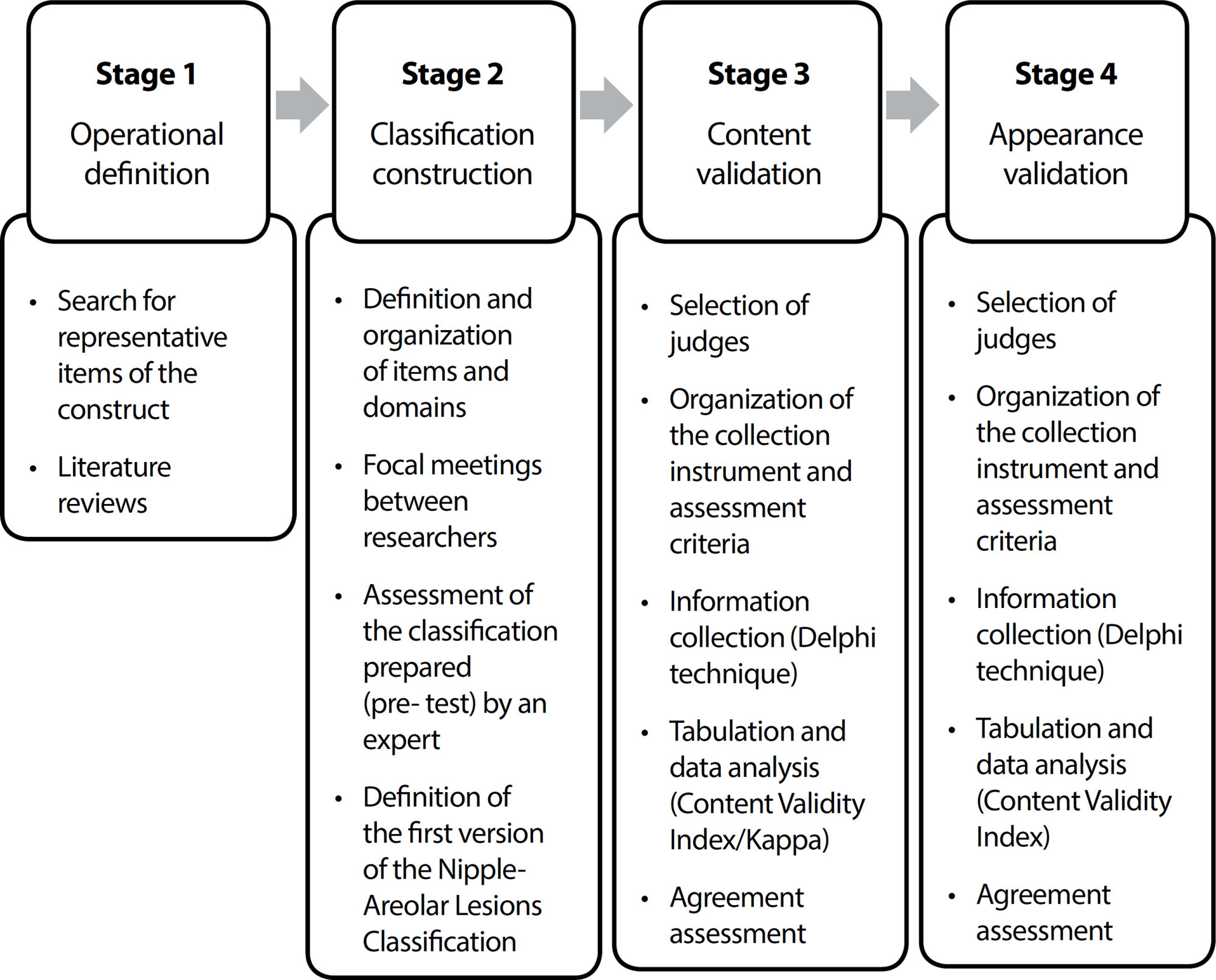
-
ORIGINAL ARTICLE09-24-2022
Patient safety in nursing technician training
Revista Brasileira de Enfermagem. 2022;75(1):e20201364
Abstract
ORIGINAL ARTICLEPatient safety in nursing technician training
Revista Brasileira de Enfermagem. 2022;75(1):e20201364
DOI 10.1590/0034-7167-2020-1364
Views0See moreABSTRACT
Objectives:
to analyze the contents on patient safety in the training of nursing technicians.
Methods:
a documentary study, conducted in three technical nursing courses at a public university in northeastern Brazil, based on the Multi-Professional Patient Safety Curriculum Guide, published by the World Health Organization.
Results:
we found that, of the 26 subjects in each course, the tracking terms were found in 22 subjects in the A/C courses, 23 in the B course. The topics of the guide with the highest number of terms were the improvement in medication safety, with 85 terms (22.6%), and Infection prevention and control, with 75 terms (20%). The contents do not express the comprehensiveness of patient safety education; some subjects had this focus, while others did not.
Conclusions:
the documents revealed gaps in the contents related to patient safety and demonstrated that they are addressed only in the course syllabus and discipline plans.
-
ORIGINAL ARTICLE03-24-2021
Content and usability validation of the Retire with Health web software
Revista Brasileira de Enfermagem. 2021;74(1):e20200133
Abstract
ORIGINAL ARTICLEContent and usability validation of the Retire with Health web software
Revista Brasileira de Enfermagem. 2021;74(1):e20200133
DOI 10.1590/0034-7167-2020-0133
Views0See moreABSTRACT
Objectives:
to validate the content and usability of the Retire with Health web software.
Methods:
a methodological study. The content validation was carried out by seven experts in the aging subject, using an instrument that evaluated the objectives, contents, relevance, and the environment of the web software. Usability was validated by seven experts in software development, referring to ergonomics, functionality, usability, and efficiency. The data were submitted to statistical analysis, described by calculating the Content Validity Index.
Results:
the global Content Validity Index found 0.97 for the usability aspects and 1.00 for the content. After incorporating all the experts’ suggestions, the Retire with Health web software was made available on the internet (www.aposentarsecomsaude.com.br).
Conclusions:
content validation and usability showed that the web software meets the objective of supporting reflection on retirement, with a high level of agreement among experts.
-
ORIGINAL ARTICLE09-06-2022
Evaluation of the health level of the elderly: patient care team considerations
Revista Brasileira de Enfermagem. 2022;75(1):e20201277
Abstract
ORIGINAL ARTICLEEvaluation of the health level of the elderly: patient care team considerations
Revista Brasileira de Enfermagem. 2022;75(1):e20201277
DOI 10.1590/0034-7167-2020-1277
Views0See moreABSTRACT
Objective:
To understand the differences of physicians, nurses, and social workers in the evaluation of the health status of the elderly.
Methods:
A cross-sectional quantitative study, using descriptive statistics. Non-probabilistic sample, consisting of 291 participants from three professional categories: 71 (24.4%) physicians, 192 (66%) nurses, and 28 (9.6%) social workers. We used a questionnaire including the variables: sociodemographic characteristics and instruments used for evaluation.
Results:
Instruments with greater utility for the evaluation of the elderly: for physicians, Mini Mental State Examination; for nurses, Braden scale; and for social workers, genogram. In the physical examination, the data most collected by physicians and nurses are the vital signs; and by social workers, the condition for performing the Activities of Daily Living.
Conclusions:
The evaluation of the elderly is based on a diversity of instruments and is an area in which health and social professionals need to share information.
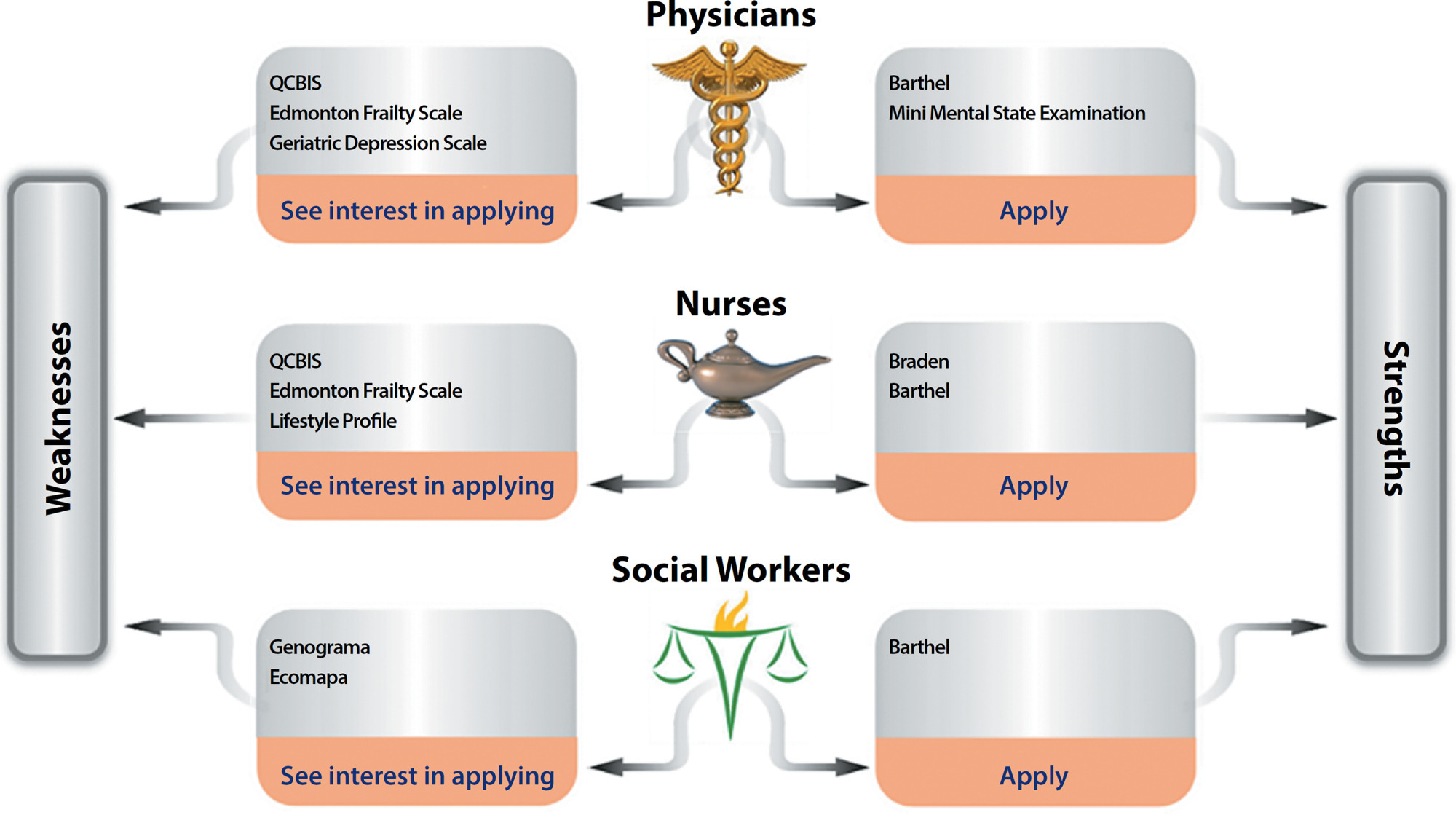
Search
Search in:
Nuvem de Tags
Adolescente (85) Atenção Primária à Saúde (239) COVID-19 (91) Criança (91) Cuidados de Enfermagem (269) Educação em Enfermagem (151) Educação em Saúde (139) Enfermagem (930) Enfermagem Pediátrica (86) Estudantes de Enfermagem (77) Estudos de Validação (131) Família (87) Idoso (208) Promoção da Saúde (99) Qualidade de Vida (104) Saúde do Trabalhador (86) Saúde Mental (145) Saúde Pública (82) Segurança do Paciente (150) Tecnologia Educacional (100)



